Themes > Features
30.06.2003
Employment trends in West Bengal
Since
the early 1990s, West Bengal like other Indian states has seen its employment
growth lagging behind output growth, so much so that even a relatively
dynamic sector like agriculture has been successful in creating very
few additional jobs.
Chart 1 indicates the change in rates of male work participation according
to the 1991 and 2001 Census of India. The Census defines 'main' workers
as those who participate in economically productive work for 183 days
or more in a year. Marginal workers, on the other hand, are those who
participate in economically productive work for less than 183 days.
While this is a measure of underemployment, obviously it would be an
underestimate, since even those with more than 183 days of work could
be underemployed.
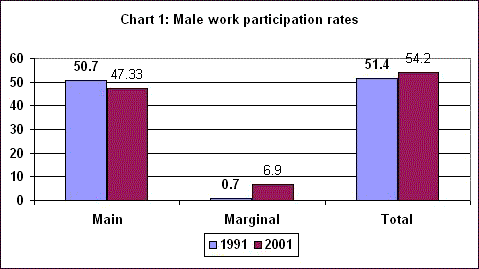
The
work participation rate of male workers in terms of main activity fell
quite significantly over the decade. Some of this was due to a rise
in participation in education, especially for those in the age group
of 1519 years, which is to be welcomed. But this reason is not enough
to explain the decline, and it is clear that the absence of productive
employment opportunities was dominantly responsible for this. Thus,
the decline in the rate of male main workers was countered by the increase
in the share of male marginal workers, which points to fewer jobs being
available over the year. It also suggests that more secure forms of
employment may have been replaced by less secure forms-a possibility
also reiterated by the NSS data on the type of contracts.
Chart 2 shows the rates of work participation of women. West Bengal
has one of the lowest rates of female work participation in the country.
However, unlike the rest of the country, these rates have been rising,
both for main and marginal workers. It is not clear how much of this
is due to better enumeration of women's work and how much is the real
trend. Even here, by far the more significant increase is in terms of
marginal work. (It should be noted that the Census definitions and coverage
of 'economically productive work' are still rather restricted and tend
to leave out a range of household related economic activity. This is
one of the reasons why women's work participation as indicated by the
Census is so low in West Bengal. The coverage by the NSS is slightly
better in this regard.)
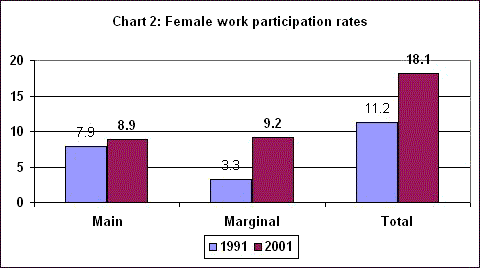
(It should be noted that the Census definitions and coverage of "economically
productive work" are still rather restricted and tend to leave
out a range of household related economic activity. This is one of the
reasons why women's work participation as indicated by the Census is
so low in West Bengal. The coverage by the NSS is slightly better in
this regard.)
Charts 3 and 4 indicate the changes in terms of main occupation, between
1991 and 2001 for men and women separately. The most significant feature
in both cases is the relative decline in agricultural work. For male
workers, the shift has been in terms of decline in the share of cultivators
(who have also declined in terms of absolute numbers). This may reflect
the increase in the share of landless households, which is reported
by the NSS, whereby few rural men report themselves as mainly working
on their own household plots. By contrast, the proportion of male agricultural
labourers has remained broadly stable at around 23 per cent. The proportion
of 'other workers' too have increased commensurately.
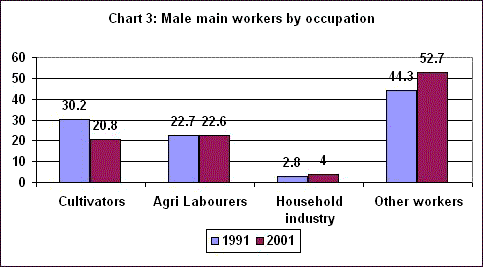
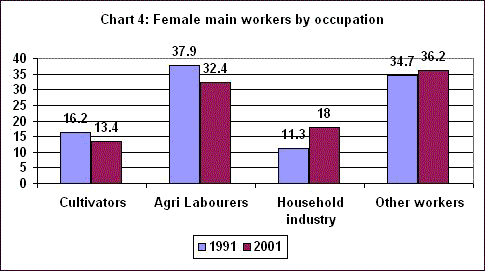
For
women workers in West Bengal, the share of both cultivators and agricultural
labourers has declined. In this case, the importance of 'household industry'
has gone up considerably, probably as part of a survival strategy of
working households, given the generally weak employment situation.
While the Census showed a substantial increase in marginal work for
both men and women in West Bengal, the results of the NSS Survey point
to a rather different conclusion. The NSS defines 'usual status' activity
as one where the person is engaged in an activity for a long period
of time in the preceding year. Within this, 'usual principal status'
refers to the main activity while 'usual subsidiary status' refers to
those who would be characterized as 'unemployed' according to the usual
status definition, but pursued some activity in a 'subsidiary' capacity.
It is evident that this corresponds approximately (but of course not
exactly) to the Census definitions of main and marginal work.
According to the NSS results, which are presented in Charts 5 and 6,
the ratio of subsidiary status workers to usual principal status workers,
has been going down for quite a long time in West Bengal, and especially
during the period 199394 to 19992000. Such declines are evident for
men and women, and for rural and urban areas. For male workers the decline
was continuous. For women workers, while the ratio increased in the
decade 1983199394, it went down substantially thereafter.
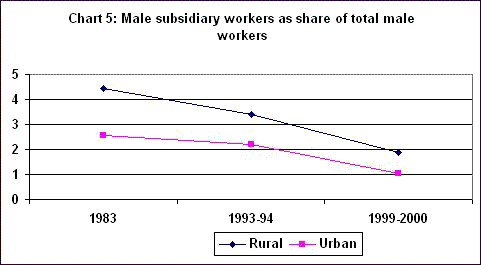

In
addition to 'usual status' activity, the NSS has other concepts of employment-the
'weekly status' employment that counts a person as employed if s/he
has been engaged in any economic activity for at least one hour on any
day of the week preceding the survey and 'daily status' employment that
defines a person as employed if s/he has worked for 4 hours or more
during the day preceding the survey. The 'usual status' definition may
be said to provide a stock estimate of the work available, since it
deals with the existence of work over a fairly long period of time.
By contrast, the 'weekly' and 'daily' status measures can be seen as
flow estimates that also give a sense of the current state of labour
demand.
Charts 7 and 8 indicate the growth of rural employment according to
the NSS, both by the 'usual status' and 'daily status' indicators. In
terms of usual activity, while male employment shows a sharp decline,
that for women has actually turned negative during the later period.
In terms of daily status, which possibly captures the real state of
the labour market from the point of view of workers more accurately,
both men and women experienced a decline in employment, after reasonable
growth in the earlier period.

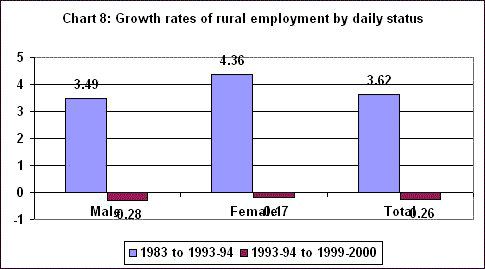
Charts 9 and 10 show the NSS results
for the same variables in the urban sector. Here the condition of male
employment appears to be slightly better, in that, while there was deceleration
in employment by both usual and daily status indicators, it was relatively
less and male employment growth continued to increase above the rate
of increase in labour force. However, female employment shows a collapse,
with absolute declines according to both indicators.
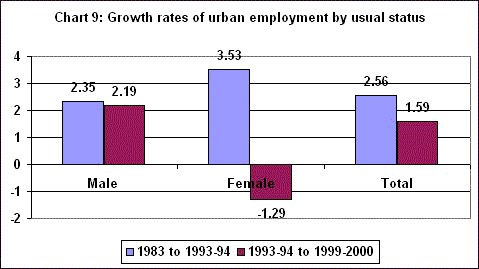

The
change in type of employment must be seen in relation to this aggregate
employment stagnation, since it defines the broader conditions under
which labour contracts change. In what follows, we consider patterns
specifically in the rural areas of West Bengal.
Chart 11 shows the changing terms of employment for rural men. It is
clear that the most significant changes are decline in regular employment
and increase in casual work. While these are part of long-term trends,
the recent period appears to have seen an acceleration in these changes.
The change in self-employment is more complex, since the share of self-employment
increased in 199394, only to come down to almost the earlier levels
by 19992000.
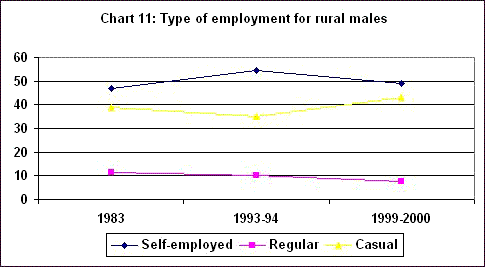
For
rural women, as shown in Chart 12, the pattern is rather different.
One has to keep in mind that the work participation rate of women in
West Bengal is already very low, and that the latest period witnessed
an absolute decline in employment. Therefore, the increase in share
of a particular type of employment does not mean an absolute increase
in such work; rather it indicates that such work declined less than
other types of work contracts.
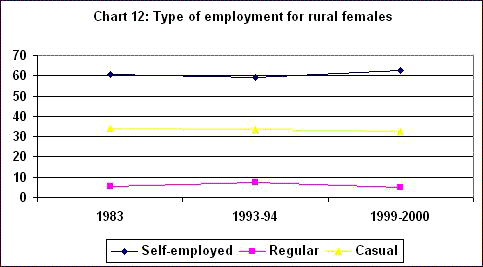
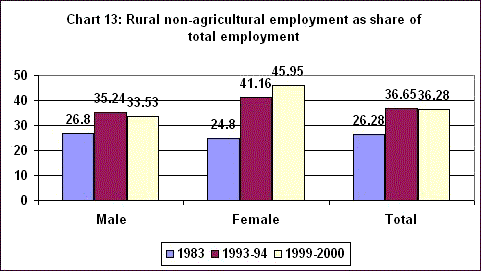
This
may be why an increase in the share of regular work and a decline in
the share of casual work can be observed for rural women. It is likely
that most of the job losses were in the sector of casual work, which
is why the share has gone down. The increase in the share of self-employment
is likely to reflect disguised unemployment in such a context, since
this can be a residual or 'refuge' activity when other paid work is
not available.
It remains to consider the extent of diversification of employment,
given the overall stagnation of employment and the changes in types
of work contract. Chart 13 describes the share of non-agricultural employment
in total rural employment (usual status, principal and subsidiary activities
taken together). The trend is clearly for an increase in the share of
non-agriculture in total employment, although this is more prominent
for women workers.
By 19992000, nearly half of the women engaged in some usual status
activity in rural West Bengal were not employed in agriculture. Once
again, given the overall decline in employment, this suggests that the
job losses for women have been greater in agriculture, rather than a
significant expansion in non-agricultural jobs. For men, the increase
in jobs in the non-agriculture sector was quite sharp till 199394,
but seems to have reduced subsequently.
Table
1 provides a picture of the overall extent of employment diversification
from agriculture by districts, using data from the 2001 Census. It needs
to be borne in mind that these shares of non-agricultural employment
(which refer to both main and marginal workers taken together) include
other primary activities (such as forestry and fishing) and also refer
to both rural and urban areas.

This
is why the shares of non-agriculture in total employment are very high,
especially for some heavily urbanized districts. While there is almost
complete absence of agricultural work in Kolkata, the share of non-agriculture
is also very high is Howrah, which is dominantly urban, part of greater
Kolkata, and in North 24 Parganas, which is also part of the greater
Kolkata hinterland, as well as in Darjeeling, which is dominated by
the city of Siliguri.
What is interesting, however, is that very few districts show a domination
of agriculture in total employment. Indeed, for male workers, only four
districts show a share of non-agriculture in total employment of less
than 40 per cent. They are among the districts that are generally considered
'backward': Uttar and Dakshin Dinajpur (with around 32 per cent each),
Bankura (36 per cent) and Birbhum (39 per cent).
For the state as a whole, well above half of those employed are engaged
in non-agricultural pursuits. This is also well above the national average
of more than 60 per cent of workers engaged in agriculture, indicating
that in West Bengal, employment diversification is relatively more advanced.
What are the areas in which such diversification has occurred and which
of these has been more dynamic? It is worth considering this in detail
by looking at the relationship between growth and employment.
It is notable that in West Bengal, the period 199394 to 19992000,
which experienced such stagnation and decline in aggregate employment
generation, actually showed a higher rate of growth of economic activity.
State Domestic Product in constant price terms actually increased at
an annual rate of 6.7 per cent, compared to 5.8 per cent in the period
1983199394. However, aggregate employment growth in the later period
in West Bengal according to the NSS was only 0.76 per cent, compared
to 2.44 per cent in the earlier period. These data reflect employment
elasticities in the recent period which are substantially lower for
West Bengal than for the rest of India.
This suggests that the problem was not growth per se so much
as the pattern of growth, which became progressively less employment-intensive.
This was especially marked in manufacturing and services (other than
transport and trade), in both of which employment actually declined,
and was despite the fact that in both sectors, output growth was impressive,
even double than the rates achieved earlier.
The pattern of services employment is surprising, given that the services
sector, particularly self-employment, is typically a residual sector
that can become a refuge for those unable to find productive employment
elsewhere. However, in West Bengal the freeze on new state government
employment after 1991 may have played a role in this. This is also reflected
in the decline in regular employment in urban areas that was indicated
by the NSS data.
While agriculture has been an important source of employment generation
in the past, the rate of growth in jobs in this sector has been declining
in the recent period. Of course, the situation in West Bengal is better
than in the rest of India, where agricultural employment has actually
fallen in the period 199394 to 19992000. This is probably because
of boro rice cultivation, which has meant increased labour demand
because of more intensive cropping in many parts of the state.
The few sectors that still show some dynamism in terms of employment
generation are wholesale and retail trade, transport and storage, and
construction. These are the sectors for which employment elasticity
has not declined during the period of 19992000. However, the dynamism
in these sectors is more prominent for urban areas; in rural areas the
impact on employment appears to be less.
Obviously, the lack of adequate employment generation is one of the
most pressing economic and social problems in West Bengal at the moment,
much as in the rest of India. But the problem seems to be even more
acute in this state than elsewhere, given the sharper declines in employment
expansion that have been noted. Clearly, this has got to be a critical
focus of future policy.
This can be achieved by moving away from those sectors that exhibit
low employment elasticity, or by changing the pattern of growth in these
sectors. Within agriculture, diversification of cropping pattern as
well as the development of improved storage and distribution facilities
enhancing cultivators' ability to grow new crops, may lead to more employment
generation. In addition, the collapse in formal finance access for farmers,
as evidenced for example in the sharp decline in rural creditdeposit
ratios of banks, must be reversed.
However, simply encouraging the shift of activities away from employment
towards manufacturing and services may not be adequate to cause employment
expansion, given the current pattern of growth in these sectors. What
is needed is a change in the nature of such growth, which would make
these activities also more labour-using than they are at present.
Within manufacturing, the basic problem seems to be that much of the
growth has come from large units, which are less employment-intensive,
even as many more labour-using small units close down. The pressure
of import competition and worsening credit access are, at one level,
national problems that are common across the states, and cannot be dealt
with through state government policy. But it is still possible to think
of methods of encouraging and safeguarding the interests of small and
more employment-intensive producers through various state-level incentives.
In services, much of the employment decline has come about because of
the ban on fresh hiring by the state government that has affected public
employment very drastically. The point is that such declines have not
been compensated for by increases in private service employment. While
services cannot be treated as one sector for policy purposes as it is
such a heterogeneous, catch-all category, it is true that there is scope
for expansion of a range of new service activities, especially IT-enabled
services which can be provided by educated workers.
The expansion of IT-enabled service activities is a process that has
entailed a drop in the proportion of educated unemployed in urban India
in general, but there is plenty of scope to develop such activities
(which range from call centres and back-office work to accountancy and
other activities) in urban areas of West Bengal. For this, of course,
better infrastructural facilities (especially power, communication and
connectivity) as well as more systematic and directed training of educated
youth are required.
On
the whole, it appears that there is scope for redirecting economic processes
within the state of West Bengal to encourage more employment generation,
notwithstanding the overall macroeconomic processes that are currently
operating to inhibit the growth of jobs.
© MACROSCAN
2003